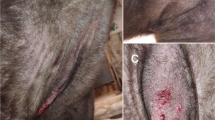Abstract.
To facilitate ecotourism and behavioral research, free-ranging mountain gorillas (Gorilla gorilla beringei) have been habituated to humans. During routine health monitoring, five juvenile gorillas were observed with active crusted dermatitis and alopecia. Papular and vesicular lesions and crusts with papular eruption and oozing were numerous and disseminated over the body of one gorilla with a confirmed infestation of scabies. In this gorilla, the hyperkeratotic crusts were loose and thick with a flaky and scaly appearance. Histologically, the epidermis was thickened, displayed hyperkeratosis and was infiltrated with lymphocytes and neutrophils. Examination of skin scraping yielded a positive identification of adults and eggs of Sarcoptes scabiei mites. The gorillas were treated with ivermectin, 200 mg kg–1. As S. scabiei mites can cross-infect various mammalian species causing self-limiting dermatitis, these ectoparasites can be propagated in the habitats shared by gorillas, people, and livestock, and therefore they represent an anthropozoonotic threat.
Similar content being viewed by others
Author information
Authors and Affiliations
Additional information
Electronic Publication
Rights and permissions
About this article
Cite this article
Graczyk, T.K., Mudakikwa, A.B., Cranfield, M.R. et al. Hyperkeratotic mange caused by Sarcoptes scabiei (Acariformes: Sarcoptidae) in juvenile human-habituated mountain gorillas (Gorilla gorilla beringei). Parasitol Res 87, 1024–1028 (2001). https://doi.org/10.1007/s004360100489
Received:
Accepted:
Issue Date:
DOI: https://doi.org/10.1007/s004360100489




